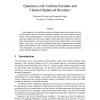Free Online Productivity Tools
i2Speak
i2Symbol
i2OCR
iTex2Img
iWeb2Print
iWeb2Shot
i2Type
iPdf2Split
iPdf2Merge
i2Bopomofo
i2Arabic
i2Style
i2Image
i2PDF
iLatex2Rtf
Sci2ools
133
Voted
DCC
2002
IEEE
2002
IEEE
Quantizers with Uniform Encoders and Channel Optimized Decoders
Scalar quantizers with uniform encoders and channel optimized decoders are studied for uniform sources and binary symmetric channels. It is shown that the Natural Binary Code and Folded Binary Code induce point density functions that are uniform on proper subintervals of the source support, whereas the Gray Code does not induce a point density function. The mean squared errors for the Natural Binary Code, Folded Binary Code, Gray Code, and for randomly chosen index assignments are calculated and the Natural Binary Code is shown to be mean squared optimal among all possible index assignments. In contrast, it is shown that almost all index assignments perform poorly and have degenerate codebooks.
Binary Symmetric Channels | Code Induce Point | Computer Graphics | DCC 2002 | Natural Binary Code |
Related Content
| Added | 25 Dec 2009 |
| Updated | 25 Dec 2009 |
| Type | Conference |
| Year | 2002 |
| Where | DCC |
| Authors | Benjamin Farber, Kenneth Zeger |
Comments (0)

